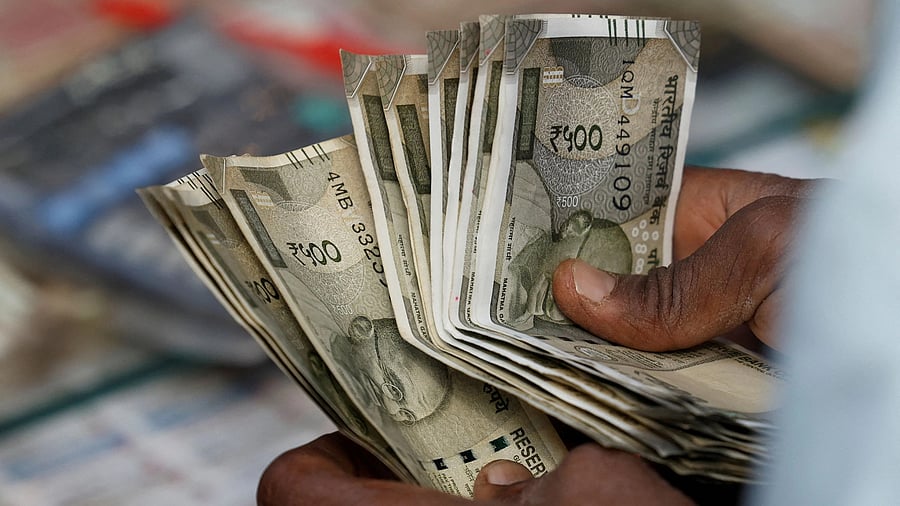
A roadside currency exchange vendor counts notes.
Credit: Reuters File Photo
Within nine years of its launch, India’s Unified Payments Interface (UPI) has emerged as the leading digital payment platform, recently clocking 650 million transactions and surpassing Visa, which is one of the oldest and largest digital payment networks. Notably, Visa recorded a daily average of 640 million transactions in FY24. This trend might suggest—or even mislead people into thinking—that India is steadily becoming a less cash-dependent economy. However, an examination of the cash in circulation (CIC) in the economy between the demonetisation period, i.e., November 2016, and today shows that CIC has more than doubled from Rs 17 lakh-crore to Rs 37 lakh-crore. What explains these two seemingly divergent trends?
CIC is a key indicator for understanding the structure of any economy. The higher the CIC, the larger the informal sector tends to be. CIC also captures public preference for cash over digital transactions. A high level of cash usage can also frustrate the central bank’s initiatives towards financial inclusion. While the absolute amount of cash increases as the economy grows, CIC as a percentage of gross domestic product (GDP) offers valuable insights into payment habits of people and the effectiveness of monetary policy. Demographics also play a role in demand for cash: young India is more inclined towards digital transactions over cash, while cash usage typically spikes during general and state assembly elections. Households often overlook the opportunity cost of holding cash, resulting in a double whammy: loss of income and the erosion in the real value of money.
Currently, CIC in India includes banknotes, central bank digital currency (CBDC), and coins. The Reserve Bank of India performs the functions relating to the issuance of currency and its management through its 19 issue offices, 2,689 currency chests, and 2,299 small coin depots across the country. While multiple denominations of banknotes are in circulation, the RBI has stopped printing Rs 2, Rs 5, and Rs 2,000 notes. The total CIC, including coins and CBDC, was Rs 37.24 lakh crore as of March 31, 2025. CIC, which was Rs 17 lakh crore in November 2016, went down to Rs 9 lakh crore by the end of December 2016 following demonetisation. Of the total CIC in value terms, the share of Rs 500 notes increased from 77 per cent in 2022-2023 to 86 per cent in 2024-2025, while the share of Rs 2,000 denomination notes decreased from 10.80 per cent to 0.2 per cent during the same period, owing to their withdrawal from circulation.
India’s currency-to-GDP ratio stood at around 12-13 per cent prior to demonetisation, reflecting a cash-heavy economy. It fell sharply to 8.7 per cent in late 2016 following the withdrawal of notes of 500 and 1000 denominations. However, as new Rs 500 and Rs 2,000 notes were introduced into the system, the ratio climbed again—reaching 14.4 per cent during the financial year 2020-2021, when the Covid-19 pandemic prompted a preference for cash holdings during lockdowns.
Since then, the ratio has been declining steadily and stood at 11.20 per cent in FY2024-25. Comparing this figure with other countries offers a more nuanced perspective. The CIC-to-GDP ratio is around 9 per cent in the United States and 10-11 per cent in the Eurozone, possibly due to the global demand for US dollars and euros as reserve currencies.
That said, there cannot be an “ideal” CIC that is applicable to all economies. Such comparisons become complex due to the different definitions of CIC adopted in different countries. Similarly, it is difficult to explain why Japan and Germany—countries that have a high level of digital adoption—have a high CIC-to-GDP ratio.
For the RBI, a bigger informal economy and higher reliance on cash by households in the formal economy can make monetary policy less effective. On the other hand, a lower CIC-to-GDP ratio can increase the central bank’s ability to manage inflation, stimulate growth, and promote financial inclusion initiatives.
The spike in transactions done through UPI, credit and debit cards, and online and mobile banking in the last decade indicates that India has a safe, secure, and reliable digital payment infrastructure. The biggest challenge—and the reason for the slow progress in the transition—is perhaps the cultural preference of people for holding cash.
Cash is still the major mode of payment in real estate and gold. Professionals such as doctors prefer cash for their services, resulting in a loss of tax revenue for the government.
There is also the cost of storing and transporting cash back and forth from the RBI, currency chests, and banks. The Reserve Bank also incurs expenses on printing notes too, which could be fresh or reissuing soiled and mutilated notes as a part of the clean note policy. Expenses on printing of currency notes by the RBI increased by 25% to Rs 6,373 crore during 2024-2025.
As India moves from being a cash-heavy economy to a less-cash economy, the CIC-to-GDP ratio will continue to fall, but it could be a slow and painful process, as it needs a cultural shift from all stakeholders, including politicians.
(Vasant, a CFA and former banker, teaches at Manipal Academy of Higher Education, Bengaluru. Soumyadip is VP and head (academics), U-Next Manipal Academy of Banking, Bengaluru)